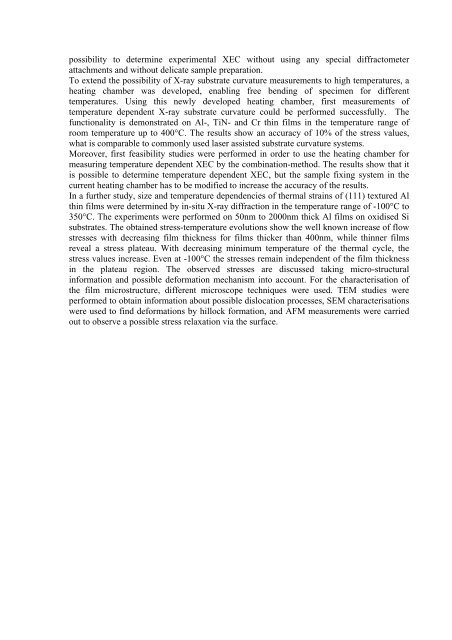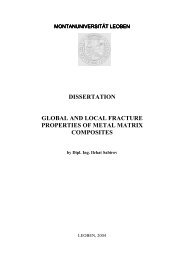in-situ röntgendiffraktion zur charakterisierung von mechanischen ...
in-situ röntgendiffraktion zur charakterisierung von mechanischen ...
in-situ röntgendiffraktion zur charakterisierung von mechanischen ...
Erfolgreiche ePaper selbst erstellen
Machen Sie aus Ihren PDF Publikationen ein blätterbares Flipbook mit unserer einzigartigen Google optimierten e-Paper Software.
possibility to determ<strong>in</strong>e experimental XEC without us<strong>in</strong>g any special diffractometer<br />
attachments and without delicate sample preparation.<br />
To extend the possibility of X-ray substrate curvature measurements to high temperatures, a<br />
heat<strong>in</strong>g chamber was developed, enabl<strong>in</strong>g free bend<strong>in</strong>g of specimen for different<br />
temperatures. Us<strong>in</strong>g this newly developed heat<strong>in</strong>g chamber, first measurements of<br />
temperature dependent X-ray substrate curvature could be performed successfully. The<br />
functionality is demonstrated on Al-, TiN- and Cr th<strong>in</strong> films <strong>in</strong> the temperature range of<br />
room temperature up to 400°C. The results show an accuracy of 10% of the stress values,<br />
what is comparable to commonly used laser assisted substrate curvature systems.<br />
Moreover, first feasibility studies were performed <strong>in</strong> order to use the heat<strong>in</strong>g chamber for<br />
measur<strong>in</strong>g temperature dependent XEC by the comb<strong>in</strong>ation-method. The results show that it<br />
is possible to determ<strong>in</strong>e temperature dependent XEC, but the sample fix<strong>in</strong>g system <strong>in</strong> the<br />
current heat<strong>in</strong>g chamber has to be modified to <strong>in</strong>crease the accuracy of the results.<br />
In a further study, size and temperature dependencies of thermal stra<strong>in</strong>s of (111) textured Al<br />
th<strong>in</strong> films were determ<strong>in</strong>ed by <strong>in</strong>-<strong>situ</strong> X-ray diffraction <strong>in</strong> the temperature range of -100°C to<br />
350°C. The experiments were performed on 50nm to 2000nm thick Al films on oxidised Si<br />
substrates. The obta<strong>in</strong>ed stress-temperature evolutions show the well known <strong>in</strong>crease of flow<br />
stresses with decreas<strong>in</strong>g film thickness for films thicker than 400nm, while th<strong>in</strong>ner films<br />
reveal a stress plateau. With decreas<strong>in</strong>g m<strong>in</strong>imum temperature of the thermal cycle, the<br />
stress values <strong>in</strong>crease. Even at -100°C the stresses rema<strong>in</strong> <strong>in</strong>dependent of the film thickness<br />
<strong>in</strong> the plateau region. The observed stresses are discussed tak<strong>in</strong>g micro-structural<br />
<strong>in</strong>formation and possible deformation mechanism <strong>in</strong>to account. For the characterisation of<br />
the film microstructure, different microscope techniques were used. TEM studies were<br />
performed to obta<strong>in</strong> <strong>in</strong>formation about possible dislocation processes, SEM characterisations<br />
were used to f<strong>in</strong>d deformations by hillock formation, and AFM measurements were carried<br />
out to observe a possible stress relaxation via the surface.
















